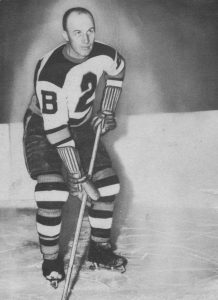This Day in Hockey History – December 5, 1939 – Bruins’ Shore Nevermore
A little over ten years after Eddie Shore set the record for most fights in one game, on December 5, 1939, the famous defenseman played his final game with the Boston Bruins.
The Bruins had just won their second Stanley Cup when Shore wished to retire and purchased the Springfield Indians of the International-American Hockey League. The Bruins had so many players injured they needed him, so manager Art Ross negotiated with Shore concerning the 1939-40 season. According to a statement Ross issued, he “did so under full authority given me by the N.H.L. to make any agreement I felt would be to the best interest of the league, to Boston hockey, and to Eddie Shore, who, while still under contract to the Bruins, had ill-advisedly invested in the Springfield club.” Victor O. Jones summarized for the Boston Globe, “Because the Boston public wouldn’t allow Shore to be tossed around, Eddie first put pressure on Ross to get excused from the road games. That hurt the gate in every N.H.L. city. Then he forced Ross to excuse him from the Bruin’s home games. That hurt hockey in Boston.” Ross spent the first months of the season claiming that he could not release Shore because another NHL team would not waive but would draft him.
Although Shore kept looking for a release, when teammate Wayne Hollett’s 4-year-old son died after a long illness, “Eddie immediately called the Bruins’ office here to express his regrets and offer his services to the B’s in Flash’s absence. Naturally Eddie’s offer was readily accepted.” Before “9800 faithful at the Garden,” Shore received “the wildest ovation of the night.” After the New York Americans scored in the first period, “none other than Mr. Edward Shore, the well-known mogul and commuter, came through in patented style with the first of the B’s markers well along in the second period.” His goal to tie up the game bounced off player Allan Murray and goalie Earl Robertson to land in net. Roy Conacher got the Bruins’ winning goal and then a penalty shot that he missed. That game on December 5th would be Shore’s last appearance for the Boston Bruins.

Eddie Shore [Public domain], via Wikimedia Commons
Throughout December and most of January, the Bruins denied that Shore would be traded but also refused to release him. They instead claimed to have loaned him to Springfield. Red Dutton of the Americans offered Ross $20,000 for Shore but was turned down. Then, two weeks later, on January 25, 1940, Ross called up Dutton to offer a trade instead. The next day, the front page of the Boston Globe reported, “Despite recent assertions that he would never play for any other NHL team, the Boston Bruins last night announced that Eddie Shore, one of the greatest players of all time and an idol of the local fans for the past 13 years, had been traded to the New York Americans for right winger, Eddie Wiseman. The Bruins reported no cash was involved. The Americans said there was.” Some bitterness seemed to show in Ross’s telegram to Shore stating, “You have been transferred to the New York Americans hockey club as our final act to satisfy you. Contact Dutton for further instructions.” Dutton commented, “Eddie and I have been friends for years, and I want to do everything possible to help him with his investment in Springfield.” He said he was not sure if Shore would play, but he was sure Shore would never be on Americans’ coaching staff. Shore claimed that Dutton gave him permission “to fulfill his obligations to the Inter-Am League of playing at least one game in each of the minor loop’s cities” in return for playing some “road games for the Americans.” In a phone call to the Globe, Shore said, “I really deeply regret leaving the Boston fans and the team. I never really thought I would wear any other N.H.L. uniform but that of Boston.” As Globe reporter Herbert Ralby summarized, “Thus ended another chapter in the screwy Shore-Bruins controversy.”
Shore had been an integral part of the Bruins since 1926. As Ralby described him, “He was the sparkplug, the dynamo, and about everything else which made the Bruins go.” Trainer Hammy Moore reminisced, “He was the only player I ever saw who had the whole arena standing every time he rushed down the ice. He would either end up bashing somebody, get into a fight or score a goal.” When Richard Johnson of the New England Sports Museum weighed in, he noted, “When the best player is also the best fighter and the best warrior on the team, that’s an unusual combination. Having the best player in the league playing for an American team had a huge impact.” Shore received the Hart Trophy four times and was inducted into the Hockey Hall of Fame in 1947. Despite their odd ending, the Boston Bruins retired Shore’s No. 2 on April 1, 1947, as only their second sweater retirement.
Additional Sources:
- Gerry Moore, “Death of Hollett’s Son Causes Shore’s Return,” Boston Globe, 5 Dec. 1939, p. 9.
- Gerry Moore, “Bruins Take Amerks by Score of 2 to 1,” Boston Globe, 6 Dec. 1939, p. 25.
- “Shore’s Jersey, O’ No. 2, Lays Over Eddie’s Bench,” Boston Globe, 13 Dec. 1939, p. 22.
- Herbert Ralby, “Bruins Trade Edmonton Eddie Shore for Wiseman of the Amerks,” Boston Globe, 26 Jan. 1940, p. 1 and 20.
- Victor O. Jones, “What About It?,” Boston Globe, 26 Jan. 1940, p. 20.
- https://www.nhl.com/news/eddie-shore-100-greatest-nhl-hockey-players/c-283935450?tid=283865022
- https://www.nhl.com/bruins/team/honored-numbers














